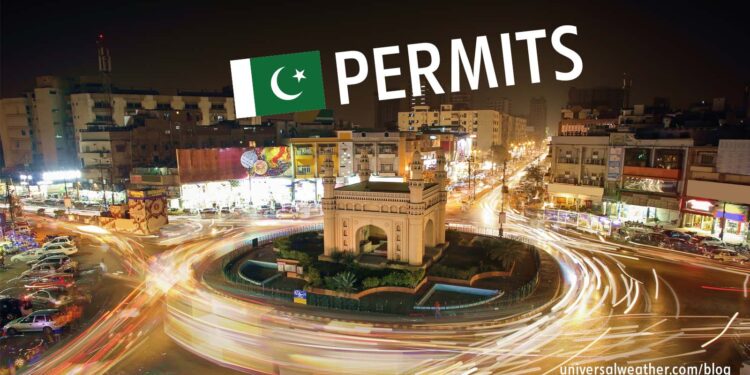HOW TO: Arranging Pakistan Landing and Overflight Permits

When you request landing and overflight permits for Pakistan, it’s important to allow for official lead time, as well as provide all required documentation/information. In the majority of cases, permits for Pakistan are not difficult to obtain for most business aircraft operators.
The following is an overview of what you need to know:
1. What are permit requirements?
Both private non-revenue and charter (non-scheduled commercial) operations require landing and overflight permits for Pakistan. Permits are processed by the Pakistan Civil Aviation Authority (CAA).
2. What information is needed for permit requests?
For landing permits private operators must provide copies of airworthiness and registration certificates and the worldwide insurance policy. Charter operators need to provide the same information, in addition to a copy of their Air Operators Certificate. The only time documents are not required for a landing permit is in the case of tech stops (no embarking or disembarking crew members or passengers), with the exception of Indian-registered aircraft. In addition landing permit requests must also include purpose of the flight, a business contact name – with address and phone and fax numbers – along with date of birth, nationality, passport number, and passport expiration date for all crew members and passengers.
3. For overflight permits what are the documentation/information requirements?
Overflight permit requests require basic information about the flight, including operator name, itinerary, purpose of flight, route of flight, expected flight level, number of crew members/passengers (with nationalities), and classification of flight (private non-revenue or charter). Required aircraft information includes state of registry, aircraft type, maximum takeoff weight, and serial number. However, no aircraft documents are needed for overflight permits, except for Indian-registered aircraft.
4. Are there special overflight permit requirements for certain registries?
Indian-registered aircraft – “VT” – are generally expected to provide the operator address, and in some cases crew member/passenger information may be requested. Note that flights to or from Israel are strictly prohibited. Overflight or landing by Israeli-registered aircraft is not permitted. In addition charter flights are not permitted to operate to/from Afghanistan. Private non-revenue flights, however, may operate to/from Afghanistan with prior permission from CAA.
5. Any other permit considerations?
Lead time for overflight permits is 96 hours, whereas it’s six days for landing permits. The lead time is the same for both private non-revenue and charter flights, and it’s required in order to provide Pakistan time to do advance security screening. Be advised that all permit requests will be reviewed by Pakistan security authorities prior to being approved by CAA. Part of the screening process – in the case of landing permits – includes getting in touch with the business contact provided on the permit request.
6. Are short-notice requests possible?
While it has been possible to obtain short-notice permits for Pakistan, this is strictly dependent on CAA’s willingness to consider short-notice requests. It’s generally best to avoid requesting short-notice permits for Pakistan.
7. How long is the permit validity time?
Overflight permits are generally valid for 72 hours from date/time initially proposed. Landing permits require revision whenever there’s a change to date of operation. For overflight permits operators are expected to adhere to proposed routings within Pakistan airspace. Any change to entry/exit point, or routing within Pakistan, requires revalidation of the permit – generally resulting in a new permit number.
8. Are some routings more difficult to obtain?
Plan on additional advance notification when requesting the “PURPA route” because permission for this particular route can be difficult to obtain. This route transits the PURPA waypoint in northeastern Pakistan when crossing Pakistan-controlled Kashmir on routes into China.
9. What are procedures for technical stops?
Technical landings are permitted in Pakistan for durations of 24 hours or less. Aircraft must follow prescribed air traffic service routes within Pakistan airspace, and, while the aircraft is on the ground, the ground handler is responsible for the safety and security of crew. If the technical stop is for purpose of crew rest, the operator must advise the ground handler which hotel the crew will be using, and this designated hotel may not be changed. No aerial photography or intelligence-gathering equipment may be carried onboard.
10. Are there special requirements when picking up passengers who do not arrive with the aircraft?
Yes. You’ll need to provide the same information – name, date of birth, nationality, passport number, and expiration date – that’s required for a landing permit. A tax of approximately $100 per passenger must be coordinated and collected by the ground handler and paid to CAA.
Conclusion
While we do not run into many issues with Pakistan overflight or landing permits, there are certain nuances to keep in mind. Considerations include prescribed routing requirements, the need to provide business contact information, and specific procedures for revising permits. Keep in mind that permits may occasionally not be granted until 24-48 hours prior to operation – even when permit requests have been submitted one week or more in advance.
Questions?
If you have any questions about this article or would like assistance obtaining your Pakistan overflight or landing permits, contact me at johnmcclelland@univ-wea.com.




